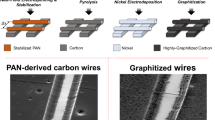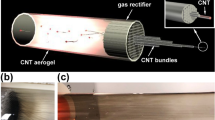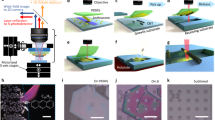Abstract
The assembly of single-walled carbon nanotubes (CNTs) into high-density horizontal arrays is strongly desired for practical applications, but challenges remain despite myriads of research efforts. Herein, we developed a non-destructive soft-lock drawing method to achieve ultraclean single-walled CNT arrays with a very high degree of alignment (angle standard deviation of ~0.03°). These arrays contained a large portion of nanometre-sized CNT bundles, yielding a high packing density (~400 µm−1) and high current carrying capacity (∼1.8 × 108 A cm−2). This alignment strategy can be generally extended to diverse substrates or sources of raw single-walled CNTs. Significantly, the assembled CNT bundles were used as nanometre electrical contacts of high-density monolayer molybdenum disulfide (MoS2) transistors, exhibiting high current density (~38 µA µm−1), low contact resistance (~1.6 kΩ µm), excellent device-to-device uniformity and highly reduced device areas (0.06 µm2 per device), demonstrating their potential for future electronic devices and advanced integration technologies.
This is a preview of subscription content, access via your institution
Access options
Access Nature and 54 other Nature Portfolio journals
Get Nature+, our best-value online-access subscription
$29.99 / 30 days
cancel any time
Subscribe to this journal
Receive 12 print issues and online access
$259.00 per year
only $21.58 per issue
Buy this article
- Purchase on Springer Link
- Instant access to full article PDF
Prices may be subject to local taxes which are calculated during checkout




Similar content being viewed by others
Data availability
All data are available in the manuscript or supplementary information. All materials and data are available on request to J.K., A.C., T.P. and E.S.
Change history
11 March 2022
A Correction to this paper has been published: https://doi.org/10.1038/s41565-022-01109-0
References
Cao, Q., Tersoff, J., Farmer, D. B., Zhu, Y. & Han, S.-J. Carbon nanotube transistors scaled to a 40-nanometer footprint. Science 356, 1369–1372 (2017).
Desai, S. B. et al. MoS2 transistors with 1-nanometer gate lengths. Science 354, 99–102 (2016).
Qiu, C. et al. Scaling carbon nanotube complementary transistors to 5-nm gate lengths. Science 355, 271–276 (2017).
Shulaker, M. M. et al. Carbon nanotube computer. Nature 501, 526–530 (2013).
Wilson, L. International Technology Roadmap for Semiconductors (ITRS) (Semiconductor Industry Association, 2013).
Collins, P. G., Arnold, M. S. & Avouris, P. Engineering carbon nanotubes and nanotube circuits using electrical breakdown. Science 292, 706–709 (2001).
Bai, Y. et al. Carbon nanotube bundles with tensile strength over 80 GPa. Nat. Nanotechnol. 13, 589–595 (2018).
Zhang, R., Zhang, Y. & Wei, F. Horizontally aligned carbon nanotube arrays: growth mechanism, controlled synthesis, characterization, properties and applications. Chem. Soc. Rev. 46, 3661–3715 (2017).
Cao, Q. et al. Arrays of single-walled carbon nanotubes with full surface coverage for high-performance electronics. Nat. Nanotechnol. 8, 180–186 (2013).
Jiang, K., Li, Q. & Fan, S. Spinning continuous carbon nanotube yarns. Nature 419, 801 (2002).
He, X. et al. Wafer-scale monodomain films of spontaneously aligned single-walled carbon nanotubes. Nat. Nanotechnol. 11, 633–638 (2016).
Jinkins, K. R. et al. Nanotube alignment mechanism in floating evaporative self-assembly. Langmuir 33, 13407–13414 (2017).
Mclean, R. S., Huang, X., Khripin, C., Jagota, A. & Zheng, M. Controlled two-dimensional pattern of spontaneously aligned carbon nanotubes. Nano Lett. 6, 55–60 (2006).
Yu, G., Cao, A. & Lieber, C. M. Large-area blown bubble films of aligned nanowires and carbon nanotubes. Nat. Nanotechnol. 2, 372–377 (2007).
Zhang, M. et al. Strong, transparent, multifunctional, carbon nanotube sheets. Science 309, 1215–1219 (2005).
Li, X. et al. Langmuir–Blodgett assembly of densely aligned single-walled carbon nanotubes from bulk materials. J. Am. Chem. Soc. 129, 4890–4891 (2007).
Wang, D., Song, P., Liu, C., Wu, W. & Fan, S. Highly oriented carbon nanotube papers made of aligned carbon nanotubes. Nanotechnol. 19, 075609 (2008).
Sun, W. et al. Precise pitch-scaling of carbon nanotube arrays within three-dimensional DNA nanotrenches. Science 368, 874–877 (2020).
Zhao, M. et al. DNA-directed nanofabrication of high-performance carbon nanotube field-effect transistors. Science 368, 878–881 (2020).
Liu, L. et al. Aligned, high-density semiconducting carbon nanotube arrays for high-performance electronics. Science 368, 850–856 (2020).
Li, Z. et al. Large area, highly transparent carbon nanotube spiderwebs for energy harvesting. J. Mater. Chem. 20, 7236–7240 (2010).
Yao, J., Yan, H. & Lieber, C. M. A nanoscale combing technique for the large-scale assembly of highly aligned nanowires. Nat. Nanotechnol. 8, 329–335 (2013).
Hu, Y. et al. Growth of high-density horizontally aligned SWNT arrays using Trojan catalysts. Nat. Commun. 6, 6099 (2015).
Deng, S. et al. High-throughput determination of statistical structure information for horizontal carbon nanotube arrays by optical imaging. Adv. Mater. 28, 2018–2023 (2016).
Liu, K. et al. Systematic determination of absolute absorption cross-section of individual carbon nanotubes. Proc. Natl Acad. Sci. USA 111, 7564–7569 (2014).
Mak, K. F. et al. Measurement of the optical conductivity of graphene. Phys. Rev. Lett. 101, 196405 (2008).
Liu, H. et al. Switching mechanism in single-layer molybdenum disulfide transistors: an insight into current flow across Schottky barriers. ACS Nano. 8, 1031–1038 (2013).
Allain, A., Kang, J., Banerjee, K. & Kis, A. Electrical contacts to two-dimensional semiconductors. Nat. Mater. 14, 1195–1205 (2015).
Guo, Y. et al. Additive manufacturing of patterned 2D semiconductor through recyclable masked growth. Proc. Natl Acad. Sci. USA 116, 3437–3442 (2019).
Smithe, K. K., English, C. D., Suryavanshi, S. V. & Pop, E. Intrinsic electrical transport and performance projections of synthetic monolayer MoS2 devices. 2D Mater. 4, 011009 (2016).
Wang, Y. et al. Van der Waals contacts between three-dimensional metals and two-dimensional semiconductors. Nature 568, 70–74 (2019).
Leong, W. S. et al. Low resistance metal contacts to MoS2 devices with nickel-etched-graphene electrodes. ACS Nano. 9, 869–877 (2015).
Liu, Y. et al. Approaching the Schottky–Mott limit in van der Waals metal–semiconductor junctions. Nature 557, 696–700 (2018).
English, C. D. et al. Improved contacts to MoS2 transistors by ultra-high vacuum metal deposition. Nano Lett. 16, 3824–3830 (2016).
Kappera, R. et al. Phase-engineered low-resistance contacts for ultrathin MoS2 transistors. Nat. Mater. 13, 1128–1134 (2014).
Shen, P. et al. Ultralow contact resistance between semimetal and monolayer semiconductors. Nature 593, 211–217 (2021).
Badaroglu, M. et al. PPAC scaling enablement for 5 nm mobile SoC technology. In Proc. 47th European Solid-State Device Conference (ESSDERC 2017) 240–243 (IEEE, 2017).
Ieong, M. et al. Transistor scaling with novel materials. Mater. Today 9, 26–31 (2006).
Naik, M. Interconnect trend for single digit nodes. In International Electron Devices Meeting Technical Digest (IEDM), San Francisco, USA, 1–5 December (IEEE, 2018).
Yakimets, D. et al. Power aware FinFET and lateral nanosheet FET targeting for 3 nm CMOS technology. In International Electron Devices Meeting Technical Digest (IEDM), San Francisco, USA, 2–6 December (IEEE, 2017).
Subramaniam, C. et al. One hundred fold increase in current carrying capacity in a carbon nanotube–copper composite. Nat. Commun. 4, 2202 (2013).
Lloyd, J. & Clement, J. Electromigration in copper conductors. Thin Solid Films 262, 135–141 (1995).
Black, J. R. Electromigration failure modes in aluminum metallization for semiconductor devices. Proc. IEEE 57, 1587–1594 (1969).
Dai, H., Wong, E. W. & Lieber, C. M. Probing electrical transport in nanomaterials: conductivity of individual carbon nanotubes. Science 272, 523–526 (1996).
Frank, S., Poncharal, P., Wang, Z. & De Heer, W. A. Carbon nanotube quantum resistors. Science 280, 1744–1746 (1998).
Yao, Z., Kane, C. L. & Dekker, C. High-field electrical transport in single-wall carbon nanotubes. Phys. Rev. Lett. 84, 2941 (2000).
Zhao, Y., Wei, J., Vajtai, R., Ajayan, P. M. & Barrera, E. V. Iodine doped carbon nanotube cables exceeding specific electrical conductivity of metals. Sci. Rep. 1, 83 (2011).
Behabtu, N. et al. Strong, light, multifunctional fibers of carbon nanotubes with ultrahigh conductivity. Science 339, 182–186 (2013).
Wang, X. et al. High‐ampacity power cables of tightly‐packed and aligned carbon nanotubes. Adv. Func. Mater. 24, 3241–3249 (2014).
Gurarslan, A. et al. Surface-energy-assisted perfect transfer of centimeter-scale monolayer and few-layer MoS2 films onto arbitrary substrates. ACS Nano. 8, 11522 (2014).
Gu, J. et al. Solution-processable high-purity semiconducting SWCNTs for large-area fabrication of high-performance thin-film transistors. Small 12, 4993–4999 (2016).
Acknowledgements
We thank F. Yang and Y. Li from Peking University for helpful discussions, and the Instrumentation and Service Center for Physical Sciences (ISCPS) at Westlake University for part of morphological characterizations. This work is partially supported by the Air Force Office of Scientific Research under the MURI-FATE program, grant no. FA9550-15-1-0514 (Y.G. and J.K.); NSFC 51672005 and Natural Science Foundation of Beijing 2212028 (A.C.), as well as by the US Army Research Office through the Institute for Soldier Nanotechnologies, under cooperative agreement no. W911NF-18-2-0048 (T.P., J.-D.Z., Y.L., P.-C.S., A.-Y.L. and J.K.), US Army Research Office under grant no. W911NF-18-1-0431 (J.W., J.-H.P. and J.K.), the STC Center for Integrated Quantum Materials, NSF grant no. DMR-1231319 (Q.J. and J.K.), the Center for Energy Efficient Electronics Science (NSF Grant No. 0939514) (P.-C.S. and J.K.) and the Office of Naval Research, grant no. N00014-19-1-2296 (L.D.).
Author information
Authors and Affiliations
Contributions
Y.G., E.S., J.-D.Z. and J.K. designed the study. Y.G. and E.S. performed material synthesis, characterization and CNT alignment. J.-D.Z. performed device, array fabrication and measurements. P.-C.S. performed the initial device fabrication and measurements. J.W. performed the flexible modelling of CNTs alignment. Y.M. performed the initial mechanism modelling of CNTs alignment. Y.L. performed the CNT ampacity measurement. S.D. conducted the measurement of CNT density. J.-H.P. performed the MOCVD synthesis of MoS2. A.-Y.L. performed the statistics of CNTs diameter from Raman measurements. S.Z. conducted polarization Raman measurements. S.Q. and Q.L. provided CNT materials. B.L., Q.J., Z.L, C.Q., L.D., S.Q. Q.L., Y.W., J.Z., T.P. and A.C. participated in data analysis. E.S., Y.G. and J.-D.Z. wrote the manuscript. All authors read and revised the manuscript.
Corresponding authors
Peer review
Peer review information
Nature Nanotechnology thanks the anonymous reviewers for their contribution to the peer review of this work.
Additional information
Publisher’s note Springer Nature remains neutral with regard to jurisdictional claims in published maps and institutional affiliations.
Supplementary information
Supplementary Information
Modelling and calculation, Supplementary Figs. 1–31, Tables 1 and 2, Notes 1 and 2, and refs. 1–18.
Rights and permissions
About this article
Cite this article
Guo, Y., Shi, E., Zhu, J. et al. Soft-lock drawing of super-aligned carbon nanotube bundles for nanometre electrical contacts. Nat. Nanotechnol. 17, 278–284 (2022). https://doi.org/10.1038/s41565-021-01034-8
Received:
Accepted:
Published:
Issue Date:
DOI: https://doi.org/10.1038/s41565-021-01034-8
This article is cited by
-
The reformation of catalyst: From a trial-and-error synthesis to rational design
Nano Research (2024)
-
One-dimensional semimetal contacts to two-dimensional semiconductors
Nature Communications (2023)
-
Biotemplated precise assembly approach toward ultra-scaled high-performance electronics
Nature Protocols (2023)
-
Mesoscopic sliding ferroelectricity enabled photovoltaic random access memory for material-level artificial vision system
Nature Communications (2022)



